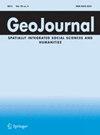燃油分配的地理位置:尼日利亚奥塔的加油站(PFS)与规划标准的位置分析和一致性
IF 1.9
Q2 GEOGRAPHY
引用次数: 0
摘要
在观察加油站的任意位置之后,本研究分析了奥贡州Ota的PFS的位置模式和符合规划标准的情况。对太田县的加油站进行了调查,以达到清点库存和记录其地理坐标的双重目的。最近邻分析用于计算最近邻指数、z分数和概率(p)值,以确定分布的模式。在Arcmap中进行了缓冲和邻近分析,分析了PFS是否符合规划标准。调查结果显示,在研究区域的15条道路上共有50家PFS,其中72%为独立营销商所有,18%为主要营销商所有,10%为NNPC所有。对加油站的空间分析表明,加油站主要集中在主干道、过渡居住区和中央商务区。最近邻指数(Rn)值为0.405547(小于1),z值为- 10.171697(小于- 1.96),p值为0.00000,PFS的分布模式显示为聚类。研究发现,只有16%的人遵守了到下一个加油站400米的距离;超过三分之二(78%)的加油站没有达到后退15米的要求;只有10%达到了住宅50米的距离要求。在其他建议中,该研究建议监管机构需要更加主动和有效。本文章由计算机程序翻译,如有差异,请以英文原文为准。
Geographies of fuel dispensing: locational analysis and conformity of petrol filling stations (PFS) to planning standards in Ota, Nigeria
Following the observation of the indiscriminate location of petrol filling stations, this study analyzes the location pattern and conformity of the PFS to planning standards in Ota, Ogun State. A survey of petrol filling stations in Ota was conducted to achieve the twin purposes of taking inventory and documenting their geographic coordinates. A nearest neighbour analysis was used to compute the nearest neighbor index, the Z-score, and the probability (p) value in order to determine the pattern of the distributions. Buffer and proximity analysis was done in Arcmap to analyze the conformity of PFS to the planning standard. The findings revealed that there are 50 PFS located along the 15 roads in the study area, of which 72% are owned by independent marketers, 18% are owned by major marketers, and 10% are owned by the NNPC. The spatial analysis of petrol filing stations indicates that PFS were more concentrated on the major roads, in the transitional residential zones, and in the Central Business Districts. With a nearest neighbor index (Rn) value of 0.405547 (less than 1), a Z-value of −10.171697 (less than −1.96), and a p value of 0.00000, the distributional pattern of PFS revealed that the pattern was clustering. The study finds only 16% complied with the 400 m distance to the next filling station; more than two-thirds (78%) of the petrol filling stations did not meet the 15 m setback requirement; and only 10% met the 50 m distance requirement to residential buildings. Among other recommendations, the study suggests the need for more proactiveness and effectiveness from the regulatory agencies.
求助全文
通过发布文献求助,成功后即可免费获取论文全文。
去求助
来源期刊

GEOJOURNAL
GEOGRAPHY-
CiteScore
4.90
自引率
7.40%
发文量
228
期刊介绍:
Aims & ScopeGeoJournal is an international journal devoted to all branches of spatially integrated social sciences and humanities. This long standing journal is committed to publishing cutting-edge, innovative, original and timely research from around the world and across the whole spectrum of social sciences and humanities that have an explicit geographical/spatial component, in particular in GeoJournal’s six major areas:- Economic and Development Geography- Social and Political Geography- Cultural and Historical Geography- Health and Medical Geography- Environmental Geography and Sustainable Development - Legal/Ethical Geography and Policy
In addition to research papers GeoJournal publishes reviews as well as shorter articles in the form of research notes, commentaries, and reports. Submissions should demonstrate original and substantive contributions to social science and humanities from a geographical perspective. Submissions on emerging new fields such as GeoEthics, Neogeography, Digital Humanities and other emerging topics are also welcome.
GeoJournal’s focus makes the journal essential reading for human geographers working in these areas, as well as for researchers from other disciplines, such as sociology, economics, political science, demography, environmental studies, urban planning, history, and cultural studies.
Last but not least, GeoJournal encourages feedbacks and discussions on articles published in the journal through letters to the editor.
GeoJournal is published bi-monthly in February, April, June, August, October and December.
 求助内容:
求助内容: 应助结果提醒方式:
应助结果提醒方式:


